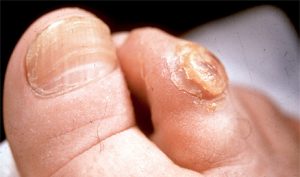
A Pesky Corn.
Corns are patches of hardened, dead skin that have been exposed to repeated pressure and rubbing. Over time, corns become raised and painful.
Corns often appear on the toe and feet especially if you’ve been wearing shoes that are too narrow. One of the most common places to develop a corn is on the side of your pinky toe.
Pinky toe corns can be quite uncomfortable, but the good news is that they often are simple to remove.
Let’s cover what they look like, and the home remedies and in-office treatments for getting rid of a corn on your pinky toe.
Appearance
Corns on your pinky toe may look inflamed or irritated. Corns are usually raised above the skin’s surface and beige-yellow in colour.
In the centre of a corn, a hard white spot (core) can be seen. Over time, the skin under the corn may develop a red, brown, or black appearance due to chronic irritation. It is important to watch for signs of infection.
Treatment and removal
A pinky toe corn can typically be treated at home. There are some situations where you might need to get professional medical help to remove it.
Filing
Pumice stones are made from naturally occurring volcanic rock. These types of stones are available at most pharmacies, beauty supply stores, and online. After soaking your foot, dry it well before using a pumice stone to apply gentle pressure to the corn and file the layers of dead skin off.
This method can take some patience, and you might need to repeat the process of soaking, drying, and gently filing the corn away.
Podiatrist
In some rare instances where a corn keeps coming back, you may need to see a Resonance Step + Stride Podiatrist to remove the corn.
Causes
Corns, also called clavus, are not at all unusual. Some people are more prone to them than others. A corn on your pinky toe may be caused by:
- shoes that aren’t wide enough, or shoes that slip up against your pinky toe when you walk
- having a job where you spend a lot of time on your feet, such as working in a restaurant, working outside, and health care
- structural problems in the shape of your feet or your toe bones
- an abnormal way of walking
People who have diabetes, joint disease such as arthritis are more likely to develop corns.
Prevention
There are some steps you can take to prevent getting a pinky toe corn in the future. These steps include:
- wearing properly fitted footwear that doesn’t rub against your pinky toe
- investing in adhesive pads or silicone sleeves that can protect your toes when you’re on your feet
- keeping your feet dry when you’re wearing shoes
- moisturizing your feet regularly
- trimming your toenails often
- regular appointments with a Resonance Step + Stride Podiatrist
When to seek help.
It’s normal for corns to cause discomfort and some dull pain. But in general, you should see a Resonance Step + Stride Podiatrist if the pain from your pinky toe corn is severe.
Other signs that you should see a doctor include:
- difficulty walking
- swollen feet
- pain that stabs or burns
- an open wound on your foot that oozes or appears infected
- yellow or green discharge coming from your pinky toe corn
The bottom line
Your pinky toe is one of the most common places for a corn to show up. Seek professional advice.
Call us today to resolve your foot pain.
0800 473 776
(09) 212 9612
#stepandstridepodiatry #respod
